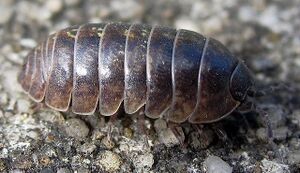Armadillidium vulgare: Difference between revisions
No edit summary |
No edit summary |
||
| Line 10: | Line 10: | ||
'''Species:''' vulgaris | '''Species:''' vulgaris | ||
[[File:Pillbug1.jpg|thumb|Armadillidium | [[File:Pillbug1.jpg|thumb|Armadillidium vulgare with a zoom lense up close]] | ||
==Description== | |||
. | |||
Revision as of 21:19, 21 April 2022
Also commonly reffered to as the Common Pillbug, Sowbugs (even though this is an incorrect classification), Roly-Polies and even Wood Lice. They are members of the Isopods, not to be confused with an insect[1]. They belong to the family Armadillidiidae and are found almost everywhere and are soil/ground dwelling isopods. These isopods can easily be spotted, as they roll into a ball to protect themselves. Pillbugs can reach over 10,000 individuals per square meter which converts to 900 individuals per square foot[2]. There are 4,000 different species of Armadillidium vulgare and are none are considered dangerous. Pillbugs do not bite, sting, or carry any diseases. They do not lay their eggs indoors. However, they may damage the roots of plants when feeding[3].
Taxonomy
Kingdom: Animalia
Subphylum: Crustacea
Class: Malacostraca
Order: Isopoda
Family: Armadillidiidae
Genus: Armadillidium
Species: vulgaris
Description
.
